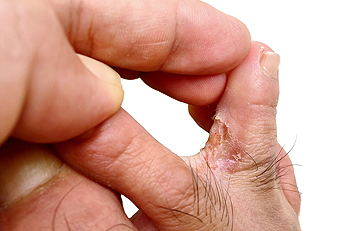
Tinea pedis, more commonly known as athlete’s foot, is considered to be a fungal skin infection. It is generally found between the toes or on the soles of the feet. The fungus enters the body through small cracks in the skin and may develop into a chronic infection. This type of fungus lives in warm and moist environments and is contagious. Some of the places where appropriate shoes are urged to be worn are public swimming pools, shower room floors, and locker rooms. There are methods that can be implemented to help prevent the spread of athlete's foot. These include keeping the toenails trimmed and airing shoes out while alternating them every other day. It is beneficial to wear shoes and socks that are made of breathable materials, which helps to keep the feet clean and dry. Athlete’s foot generally does not heal on its own, and a podiatrist is often consulted who can provide an accurate diagnosis and offer correct treatment options.
Athlete’s Foot
Athlete’s foot is often an uncomfortable condition to experience. Thankfully, podiatrists specialize in treating athlete’s foot and offer the best treatment options. If you have any questions about athlete’s foot, consult with one of our podiatrists from Jill Einhorn, DPM and James Einhorn, DPM. Our doctors will assess your condition and provide you with quality treatment.
What Is Athlete’s Foot?
Tinea pedis, more commonly known as athlete’s foot, is a non-serious and common fungal infection of the foot. Athlete’s foot is contagious and can be contracted by touching someone who has it or infected surfaces. The most common places contaminated by it are public showers, locker rooms, and swimming pools. Once contracted, it grows on feet that are left inside moist, dark, and warm shoes and socks.
Prevention
The most effective ways to prevent athlete’s foot include:
Symptoms
Athlete’s foot initially occurs as a rash between the toes. However, if left undiagnosed, it can spread to the sides and bottom of the feet, toenails, and if touched by hand, the hands themselves. Symptoms include:
Diagnosis and Treatment
Diagnosis is quick and easy. Skin samples will be taken and either viewed under a microscope or sent to a lab for testing. Sometimes, a podiatrist can diagnose it based on simply looking at it. Once confirmed, treatment options include oral and topical antifungal medications.
If you have any questions, please feel free to contact our offices located in Brooklyn and Astoria, NY . We offer the newest diagnostic and treatment technologies for all your foot care needs.